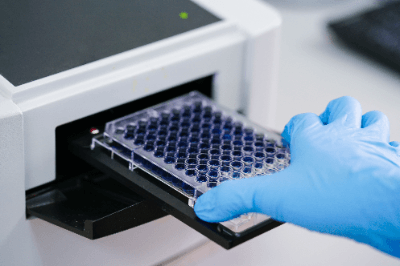What Is a Microplate Reader?

A microplate reader is a laboratory device designed to simultaneously measure the absorbance or luminescence intensity of various samples placed in a microplate.
Depending on the microplate’s well capacity, it can analyze dozens or even hundreds of samples at once, significantly enhancing laboratory efficiency. These instruments are pivotal in chemistry and biology research, particularly for quantifying proteins.
Despite their efficiency, it’s crucial to acknowledge that microplate readers may be susceptible to errors when measuring minute quantities, emphasizing the importance of understanding their characteristics and limitations.
Applications of Microplate Readers
Microplate readers are instrumental in chemistry and biology for measuring absorbance in the ultraviolet and visible light spectrum for protein quantification and cell proliferation, as well as for assessing concentrations through luminescence or fluorescence reactions.
Historically, radioluminescence was a common method for concentration analysis, but advancements in luminescence substrates and fluorescent probes have shifted experimental techniques towards safer, non-radioactive methods.
These devices streamline the handling of numerous samples, reducing the workload on researchers. They are also versatile, allowing for sample pretreatment or monitoring absorbance changes over time, with many readers facilitating in-situ reactions and subsequent measurements.
Principle of Microplate Readers
Microplate readers operate on principles of absorbance and fluorescence measurement, each requiring monochromatic light, achieved via optical filters or monochromators for wavelength selection.
1. Absorbance Measurement
Absorbance is assessed by directing light of a specific wavelength through a sample in the microplate and measuring the transmitted light’s intensity. Absorbance, proportional to concentration according to the Beer-Lambert law, allows for concentration determination by comparison with a known calibration curve. However, measurements can be compromised by microplate damage, contamination, or air bubbles within the sample.
2. Fluorescence Measurement
This method measures the intensity of fluorescence emitted by a sample upon excitation by light of a specific wavelength. The fluorescent materials absorb this light, become excited, and then release energy as they return to their ground state, emitting detectable light proportional to concentration. This specificity provides high sensitivity and accuracy in measurements.
How to Select Microplate Readers
Choosing the right microplate reader depends on the intended measurement method, including absorbance, luminescence, or fluorescence. Multi-mode readers capable of switching between different measurement principles are also available.
It’s essential to consider the light source’s wavelength range and the settable measurement wavelengths to ensure compatibility with your experiments. Additionally, the available measurement and analysis options, along with the software’s functionality, should align with your research needs, particularly for applications like enzyme kinetics or frequent quantification tasks.